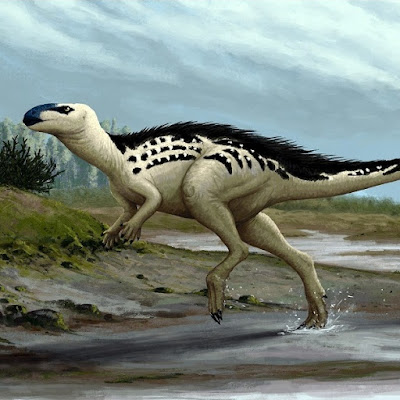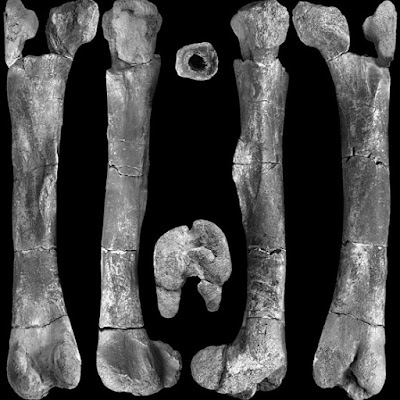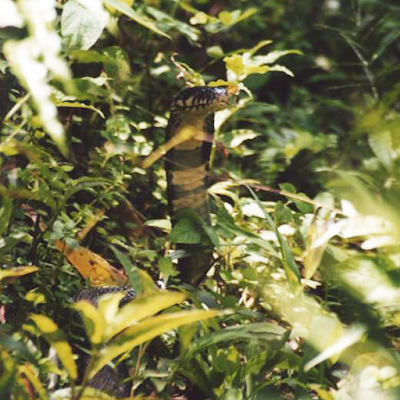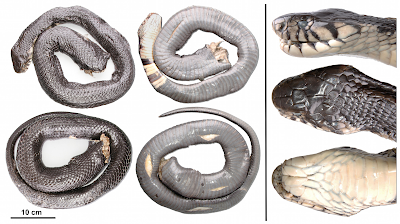[Most Recent Entries] [Calendar View]
Tuesday, September 26th, 2017
| Time | Event | ||||||
| 5:33a | [Paleontology • 2017] Burianosaurus augustai • A Basal Ornithopod Dinosaur from the Cenomanian of the Czech Republic
Abstract During their long evolutionary history, neornithischian dinosaurs diverged into several clades with distinctive adaptations. However, the early evolution within Neornithischia and the resolution of the phylogenetic relationships of taxa situated near the base of the clade remain problematic. This is especially true for those taxa traditionally placed at the base of Ornithopoda, either as ‘hypsilophodontids’ or at the base of the diverse clade Iguanodontia. Recent studies are improving our understanding of the anatomy and relationships of these taxa, with discoveries of several new non-ankylopollexian ornithopods from South America and Europe providing key insights into early ornithopod evolution and palaeobiogeography. Here, we describe a new basal ornithopod, Burianosaurus augustai gen. et sp. nov., based on a well-preserved femur from the upper Cenomanian strata (Korycany Beds of the Peruc-Korycany Formation) of the Czech Republic. The new taxon is diagnosed by a unique suite of characters and represents the only occurrence of a Cenomanian non-avian dinosaur in Central Europe north of the Alpine Tethyan areas. Histological examination of the type specimen reveals the presence of a loosely packed Haversian system which suggests relatively mature bone from a possible young adult. Phylogenetic analyses of two different data sets, selected to test the placement of B. augustai in various parts of the neornithischian tree, reconstruct B. augustai as a basal ornithopod, firmly nested outside Ankylopollexia. These results also support a diverse Elasmaria as a basal clade within Ornithopoda and reconstruct Hypsilophodon outside Ornithopoda as the sister taxon to Cerapoda. However, the relationships of ‘hypsilophodontids’ within Neornithischia remain contentious. Keywords: Ornithopoda, Dinosauria, phylogeny, Cenomanian, Czech Republic
Systematic palaeontology Dinosauria Owen, 1842Ornithischia Seeley, 1887 Neornithischia Cooper, 1985 Ornithopoda Marsh, 1881 Genus Burianosaurus gen. nov. 2005 cf. Iguanodontidae gen. et sp. indet. Fejfar, Košťák, Kvacek, Mazuch, & Moucka: 297, fig. 3. Age. Late Cenomanian, early Late Cretaceous. Derivation of name. The name Burianosaurus is derived from the surname of the Czech palaeoartist Zdenek Burian (1905–1981) who greatly influenced the perception of dinosaurs during most of the twentieth century, and saῦro & (sauros), the Greek word for ‘reptile’ or ‘lizard’. Burianosaurus augustai sp. nov. Holotype. NMP Ob 203, a well-preserved, nearly complete left femur. Derivation of name. The name augustai refers to the prominent Czech palaeontologist and prolific science populariser Josef Augusta (1903–1968).
Conclusions Only two definitive non-avian dinosaur specimens have been described from the Czech Republic to date: NMP Ob 203, a well-preserved left femur from the upper Cenomanian (Upper Cretaceous), introduced by Fejfar et al. (2005) under temporary catalogue number IGP MZHLZ/ 2003/1, and IGS-MJ-0001 (currently DGSMU Pa 222), an isolated tetanurine tooth crown from the Oxfordian (Upper Jurassic) published by Madzia (2014).A re-evaluation of the phylogenetic relationships of NMP Ob 203 demonstrates that this specimen actually represents a non-ankylopollexian ornithopod, here named Burianosaurus augustai gen. et sp. nov. Analysis of a modified version of the Boyd (2015) basal neornithischian data set reconstructs B. augustai as a basal member of Ornithopoda, positioned more rootward than the rhabdodontomorphs but more derived than the Gondwanan elasmarians. The new taxon can be distinguished from all other ornithopods by a unique suite of morphological characters present in the femur. From a palaeobiogeographical perspective, B. augustai represents the only occurrence of a non-avian dinosaur from the Cenomanian of Central Europe north of the Alpine Tethyan areas (Fejfar et al. 2005; Csiki-Sava et al. 2015). This discovery adds to the growing body of work demonstrating the importance of the European fossil record for studying the evolution of non-ankylopollexian ornithopods (e.g. Ősi et al. 2012; Ruiz-Omeñaca et al. 2012). Daniel Madzia, Clint A. Boyd and Martin Mazuch. 2017. A Basal Ornithopod Dinosaur from the Cenomanian of the Czech Republic. Journal of Systematic Palaeontology. DOI: 10.1080/14772019.2017.1371258 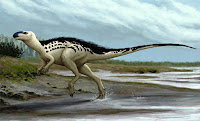 Reconstruction of the possible form of the first "Czech" dinosaur, which was named Burianosaurus augustai. Only the femur is preserved from the specimen, so based on data on related species.... Illustration: Edyta Felcyn, První český dinosaurus se změnil: byl primitivnější a nebyl zakrslý technet.idnes.cz/cesko-kosti-dinosaurus-b We describe the first dinosaur skeletal remains found in the Czech Republic, consisting of one complete femur and indeterminable bone fragments. They were recovered from the upper Cenomanian near-shore marine sediments deposited on the slopes of an ancient archipelago, several kilometres north of the larger Rhenish-Bohemian Island that was situated in what is now the middle of Europe. Sediments yielding dinosaur remains are of late Cenomanian age, Inoceramus pictus-I. pictus bohemicus inoceramid zone of the local lithostratigraphic unit, the Peruc-Korycany Formation. These are the first uncontested dinosaurian fossils reported from this formation and also the first Cenomanian dinosaur record in Central Europe. They document a small ornithopod belonging to an iguanodontid species comparable with similar Late Cretaceous European forms. The herbivorous dinosaur lived among a vegetation transitional between salt marsh flora, with abundant halophytic conifer Frenelopsis alata; and an alluvial plain assemblage dominated by lauroid angiosperms. Key words: Dinosauria, Iguanodontidae, palaeoenvironment, vegetation, Cenomanian, Bohemian Cretaceous Basin, Czech Republic, Europe. Oldřich Fejfar, Martin Košťák, Jiří Kvaček, Martin Mazuch, and Michal Moučka. 2005. First Cenomanian dinosaur from Central Europe (Czech Republic). Acta Palaeontologica Polonica. 50(2); 295-300. app.pan.pl/article/item/app50-295.html | ||||||
| 8:07a | [Herpetology • 2017] Naja peroescobari • A New Species of Naja Laurenti, 1768 (Squamata: Elapidae): The “Cobra-preta” of São Tomé Island, Gulf of Guinea
Abstract The Cobra-Preta (black snake in Portuguese) of Sao Tomé Island in the Gulf of Guinea has historically been referred to as Naja (Boulengerina) melanoleuca (Squamata: Elapidae). Its presence on the island has been traditionally explained as an introduction from the mainland by Portuguese settlers, supposedly to control the rat population. This explanation has been widely accepted by local authorities and even international conservation agencies. The taxonomic identity of this snake has remained undisputed by all taxonomists who have published about it, with the exception of L. Capocaccia in 1961. Arguments supporting the human introduction hypothesis are weak and are contradicted by historical, morphological and molecular data. Further, the biogeographic history of the Gulf of Guinea oceanic islands and recent insights on the taxonomic identity and evolutionary history of other taxonomic groups occurring there suggest that the Cobra-Preta, in fact, represents a distinct lineage of the melanoleuca group, endemic to São Tomé. We here describe the Cobra Preta as a new species. The new species differs from N. (B.) melanoleuca, its sister species, by a distinct coloration ventral pattern and the type of contact of the sublingual scales. Data on the toxicology, distribution, ecology, folklore and conservation status of the new species are presented. Keywords: Reptilia, Naja, Boulengerina, taxonomy, São Tomé & Príncipe, conservation, Naja (Boulengerina) peroescobari sp. nov.
Luis M. P. Ceríaco, Mariana P. Marques, Andreas Schmitz and Aaron M. Bauer. 2017. The “Cobra-preta” of São Tomé Island, Gulf of Guinea, is A New Species of Naja Laurenti, 1768 (Squamata: Elapidae). Zootaxa. 4324(1); 121–141. DOI: 10.11646/zootaxa.4324.1.7 | ||||||
| 3:44p | [Crustacea • 2017] Diogenes heteropsammicola • A New Species of Hermit Crab (Decapoda, Anomura, Diogenidae) Replaces A Mutualistic Sipunculan in A Walking Coral Symbiosis
Abstract Symbiont shift is rare in obligate mutualisms because both the partners are reciprocally dependent on and specialized to each other. In the obligate accommodation–transportation mutualism between walking corals and sipunculans, however, an unusual saltatory symbiont shift was discovered. In shallow waters of southern Japan, an undescribed hermit crab species was found living in corallums of solitary scleractinian corals of the genera Heterocyathus and Heteropsammia, replacing the usual sipunculan symbiont. We described the hermit crab as a new species Diogenes heteropsammicola (Decapoda, Anomura, Diogenidae), and explored its association with the walking corals. This hermit crab species obligately inhabits the coiled cavity of the corals, and was easily distinguished from other congeneric species by the exceedingly slender chelipeds and ambulatory legs, and the symmetrical telson. Observations of behavior in aquaria showed that the new hermit crab, like the sipunculan, carries the host coral and prevents the coral from being buried. This is an interesting case in which an organism phylogenetically distant from Sipuncula takes over the symbiotic role in association with a walking coral. The hermit crab species is unique in that its lodging is a living solitary coral that grows with the hermit crab in an accommodation–transportation mutualism.
Taxonomic account Genus Diogenes Dana, 1851 Diogenes heteropsammicola sp. nov. Remarks: Diogenes heteropsammicola sp. nov. belongs to the D. edwardsii species group because of the intercalary rostriform process being smooth on the lateral margins, the antennal peduncle distinctly overreaching the distal corneal margin, and the antennal flagellum bearing a pair of long setae on the distal margin of each article ventrally. The new species is readily distinguished from all other species in this group by its exceedingly slender chelipeds and ambulatory legs, its symmetrical telson, red and white coloration, and the unique symbiotic habit with solitary corals. Etymology: The new species is named after its mutualistic relationship with the solitary scleractinian corals of the genera Heteropsammia, keeping in mind that this hermit crab is also associated with Heterocyathus corals. Distribution: At present, known only from Oshima Strait, between Kakeroma Island and Amami-Oshima Island, Kagoshima, Japan, depths of 60–80 m, and Ikomo Bay, western coast of Kakeroma Island, depth of 31 m. Momoko Igawa and Makoto Kato. 2017. A New Species of Hermit Crab, Diogenes heteropsammicola (Crustacea, Decapoda, Anomura, Diogenidae), Replaces A Mutualistic Sipunculan in A Walking Coral Symbiosis. PLoS ONE. 12(9); e0184311. DOI: 10.1371/journal.pone.0184311 New hermit crab uses live coral as its home |
| << Previous Day |
2017/09/26 [Calendar] |
Next Day >> |
